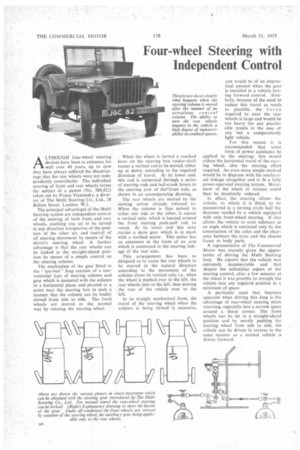Four-wheel Steering with Independent Control
Page 38

If you've noticed an error in this article please click here to report it so we can fix it.
ALTHOUGH four-wheel steering devices have been in existence for well over 40 years, up to now they have always suffered the disadvantage that the rear wheels were not independently controllable, The individual steering of front and rear wheels forms the subject of a patent (No. 580,422) taken out by Prince Viazemsky, a director of The Multi Steering Co., Ltd., 28 Bolton Street, London, W.I.
The principal advantages of the Multi Steering system are independent control of the steering of both front and rear wheels, enabling one set to be turned in any direction irrespective of the position of the other set, and control of all steering movement by means of the driver's steering wheel. A further advantage is that the rear wheels can be locked in the straight-ahead position by means of a simple control on the steering column.
The mechanism of the gear fitted to the " test-bed " Jeep consists of a conventional type of steering column and gear which is mounted with the column in a horizontal plane and pivoted at a point near the steering box in such a manner that the column can be bodily slewed from side to side. The front wheels are steered in the normal way by rotating the steering wheel.
When the wheel is turned a cranked lever on the steering box rocker-shaft causes a vertical rod to be moved, either up or down, according to the required direction of travel. At its lower end, this rod is connected through a series of steering rods and bell-crank levers to the steering arm of the', front axle, as shown in an accompanying drawing.
The rear wheels are steered by the stewing action already referred to. When the column is thus moved to either one side or the other, it causes a vertical tube, which is located around the front steering push-pull rod, to rotate. At its lower end this tube carries a skew gear which is in mesh with a toothed sector. This sector has an extension in the form of an arm which is connected to the steering linkage of the rear axle.
This arrangement has been so designed as to cause the rear wheels to be steered in the natural direction according to the movement of the column about its vertical axis, i.e., when the wheel is pushed over to the left, the rear wheels tun, to the left, thus moving the rear of the vehicle over to the left.
In its straight mechanical form, the travel of the 'steering wheel when the column is being slewed is excessive, and would be of an impractical amount when the gear is installed in a vehicle having forward control. Similarly, because of the need to reduce this travel as much as possible, the f or ce required to steer the rear wheels is large and would be too heavy for any practicable results in the case of any but a comparatively light vehicle.
For this reason it is recommended that some form of power assistance be applied to the steering; this would reduce the horizontal travel of the steering wheel, also the steering effort required. An even more simple method would be to dispense with the mechanical linkage altogether and to fit a fully power-operated steering system. Movement of the wheel or column could then be drastically reduced.
In effect, the steering allows the vehicle, to which it is fitted, to be manceuvred in a turning circle half the diameter needed by a vehicle equipped with only front-wheel steering. It also allows the vehicle to crab sideways at an angle which is restricted only by the construction of the axles and the clearance between the tyres and the chassis frame or body parts.
A representative of The Commercial Motor was recently given the opportunity of driving the Multi Steering Jeep. He reports that the vehicle was extremely manceuvrable and that despite the unfamiliar astiect of the steering control, after a few minutes at the wheel it was possible to inveigle the vehicle into any required position in a minimum of space.
A particular asset that becomes apparent when driving this Jeep is the advantage of rear-wheel steering when reversing, especially into a narrow space around a sharp corner. The front wheels can be set in a straight-ahead position and by merely pushing the steering wheel from side to side. the vehicle can be driven in reverse in the same manner as a normal vehicle is driven forward.




























































































